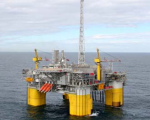A tabletop device invented at Rice University can tell how efficiently a nanoparticle would travel through a well, and may provide a wealth of information for oil and gas producers. The device gathers data on how tracers - microscopic particles that can be pumped into and recovered from wells - move through deep rock formations that have been opened by hydraulic fracturing.
Drilling companies use fracturing to pump oil and gas from previously unreachable reservoirs. Fluids are pumped into a wellbore under high pressure to fracture rocks, and materials called “proppants,” like sand or ceramic, hold the fractures open. "They' re basically making a crack in the rock and filling it with little beads," said Rice chemist Andrew Barron, whose lab produced the device detailed in the Royal Society of Chemistry journal Environmental Science Processes and Impacts.
But the companies struggle to know which insertion wells - where fluids are pumped in - are connected to the production wells, where oil and gas are pumped out. "They may be pumping down three wells and producing from six, but they have very little idea of which well is connected to which," he said.
Tracer or sensor particles added to fracturing fluids help solve that problem, but there' s plenty of room for optimization, especially in minimizing the volume of nanoparticles used now, he said. "Ideally, we would take a very small amount of a particle that does not interact with proppant, rock or the gunk that' s been pumped downhole, inject it in one well and collect it at the production well. The time it takes to go from one to the other will tell you about the connectivity underground."
Barron explained the proppant itself accounts for most of the surface area the nanoparticles encounter, so it' s important to tune the tracers to the type of proppant used.
He said the industry lacks a uniform method to test and optimize custom-designed nanoparticles for particular formations and fluids. The ultimate goal is to optimize the particles, so they don' t clump together or stick to the rock or proppant, and can be reliably identified when they exit the production well.
The automated device by Barron, Rice alumnus Samuel Maguire-Boyle and their colleagues allows them to run nanotracers through a small model of a geological formation, and quickly analyze what comes out the other side.
The device sends a tiny amount of silver nanoparticle tracers in rapid pulses through a solid column, simulating the much longer path the particles would travel in a well. That gives the researchers an accurate look at both how sticky and how robust the particles are.
"We chose silver nanoparticles for their plasmon resonance,” said Barron. “They' re very easy to see (with a spectroscope) making for high-quality data.” He said silver nanoparticles would be impractical in a real well, but because they' re easy to modify with other useful chemicals, they are good models for custom nanoparticles.
"The process is simple enough that our undergraduates make different nanoparticles and very quickly test them to find out how they behave," Barron said.
The method also shows promise for tracking water from source to destination, which could be valuable for government agencies that want to understand how aquifers are linked or want to trace the flow of elements like pollutants in a water supply, he said.
Barron said the Rice lab won' t oversee production of the test rig, but it doesn' t have to. "We just published the paper, but if companies want to make their own, it includes the instructions. The supplementary material is basically a manual for how to do this," he said.
Co-authors of the paper include Rice undergraduates David Garner, Jessica Heimann and Lucy Gao, and graduate alumnus Alvin Orbaek.
The Robert A. Welch Foundation supported the research.
Providing useful resources, articles and writings on crude oil, other petroleum products, energy and gas. By O'Niel Petroserve Nigeria Ltd, online.

 O'NielPetroserve is a leader in the of Nigerian Bonny Light Crude Oil (BLCO) sales market. As a privately held company, O'Neil Petroserve is committed to and is focused on delivering reliable services to all her clients.
O'NielPetroserve is a leader in the of Nigerian Bonny Light Crude Oil (BLCO) sales market. As a privately held company, O'Neil Petroserve is committed to and is focused on delivering reliable services to all her clients.  O'Neil Petroserve has an excellent track record of reliability in the supply of Bonny light crude oil, BLCO. We protect our buyers with 2% Performance Bond while we also expect protection from our customers with bank instrument from the world's top banks. We deliver on TTO, TTT, CIF and FOB basis.
O'Neil Petroserve has an excellent track record of reliability in the supply of Bonny light crude oil, BLCO. We protect our buyers with 2% Performance Bond while we also expect protection from our customers with bank instrument from the world's top banks. We deliver on TTO, TTT, CIF and FOB basis.
